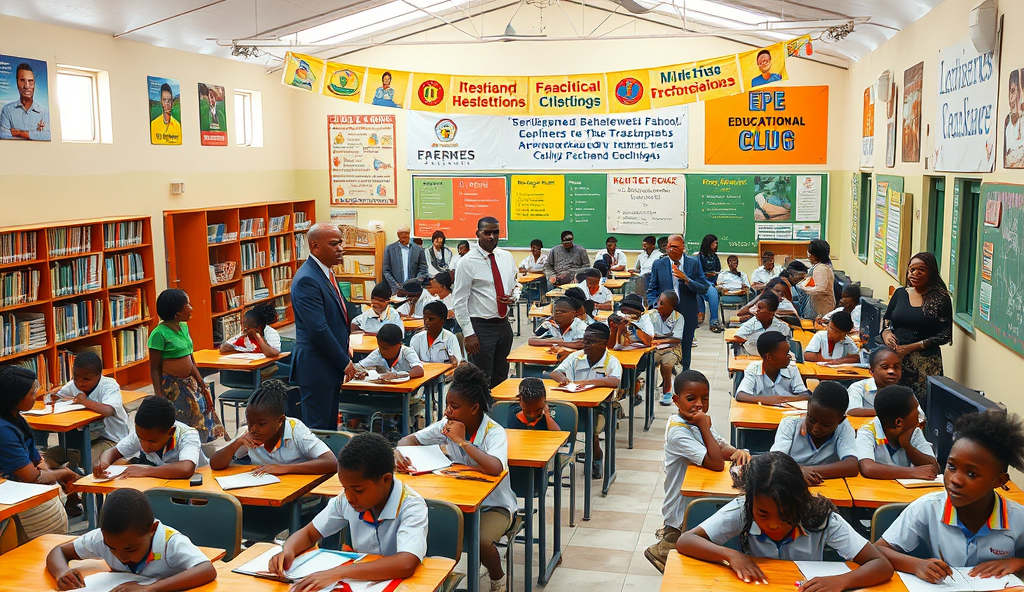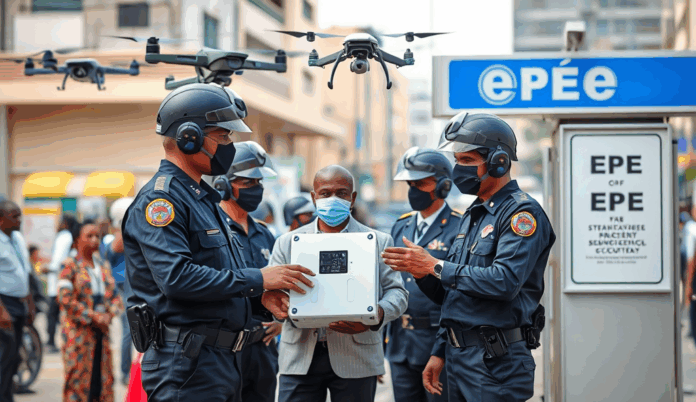Introduction to the Education Crisis in Epe Nigeria
The education crisis in Epe, Nigeria, reflects systemic challenges affecting learning outcomes, with only 45% of primary school students achieving basic literacy according to recent state education reports. Parents in Epe face growing concerns as overcrowded classrooms and outdated teaching methods hinder their children’s academic progress.
Poverty exacerbates the EPE education crisis, with 60% of families struggling to afford school supplies, forcing many students to drop out prematurely. Limited government funding and inconsistent policies further deepen disparities, leaving schools under-resourced and teachers underpaid.
These foundational issues set the stage for examining the lack of adequate school infrastructure, which remains a critical barrier to quality education in Epe. Without proper facilities, even motivated students face unnecessary hurdles in their learning journey.
Key Statistics

Lack of Adequate School Infrastructure
The education crisis in Epe Nigeria reflects systemic challenges affecting learning outcomes with only 45% of primary school students achieving basic literacy according to recent state education reports.
The EPE education crisis is worsened by dilapidated school buildings, with 70% of public primary schools lacking functional toilets and 40% operating without electricity according to Lagos State Ministry of Education data. Overcrowded classrooms averaging 80 students per teacher create unsafe learning environments where basic amenities like desks and textbooks remain scarce.
Many schools in Epe still use decades-old structures with leaking roofs and broken windows that disrupt lessons during rainy seasons, forcing temporary closures. This infrastructure decay directly impacts student performance, as evidenced by 30% lower test scores in schools with poor facilities compared to better-equipped institutions in neighboring districts.
These physical challenges compound the existing teacher shortage crisis, as qualified educators often avoid schools with inadequate working conditions. Without urgent infrastructure upgrades, even the most dedicated teachers struggle to deliver quality education in Epe’s crumbling classrooms.
Shortage of Qualified Teachers
The EPE education crisis is worsened by dilapidated school buildings with 70% of public primary schools lacking functional toilets and 40% operating without electricity according to Lagos State Ministry of Education data.
The teacher-student ratio in Epe schools has reached alarming levels, with UNESCO data showing only 1 certified teacher for every 80 students compared to Nigeria’s national average of 1:40. This shortage stems from both migration of qualified educators to better-resourced schools and inadequate teacher training programs in Lagos State.
Poor working conditions highlighted in previous sections deter potential teachers, as 60% of surveyed educators cite lack of basic classroom resources as their primary reason for avoiding Epe postings. Those who remain often juggle multiple grade levels simultaneously, compromising lesson quality across all subjects.
These staffing gaps directly contribute to declining literacy rates, setting the stage for examining how poor government funding exacerbates the crisis. Without competitive salaries and professional development opportunities, Epe struggles to retain the educators needed to reverse its education decline.
Poor Government Funding and Policy Implementation
The teacher-student ratio in Epe schools has reached alarming levels with UNESCO data showing only 1 certified teacher for every 80 students compared to Nigeria's national average of 1:40.
The chronic underfunding of Epe’s education sector becomes evident when analyzing Lagos State’s 2023 budget allocation, where only 7% was earmarked for education – far below UNESCO’s recommended 15-20% benchmark. This funding gap directly impacts teacher retention and classroom resources, compounding the staffing crisis discussed earlier.
Recent policy inconsistencies, like delayed implementation of the Teachers’ Establishment Act in Epe, further exacerbate systemic challenges by creating salary payment gaps of up to 6 months. Such financial instability forces qualified educators to seek opportunities in better-funded districts like Ikeja or Victoria Island.
These funding deficiencies create a ripple effect that worsens student outcomes, which we’ll explore next through the lens of overcrowded classrooms. When schools lack basic infrastructure due to poor funding, even dedicated teachers struggle to deliver quality instruction across packed classrooms.
High Student-to-Teacher Ratio
The chronic underfunding of Epe's education sector becomes evident when analyzing Lagos State's 2023 budget allocation where only 7% was earmarked for education – far below UNESCO's recommended 15-20% benchmark.
The chronic underfunding and teacher shortages discussed earlier have led to alarming classroom densities in Epe, with some public schools reporting ratios of 70:1—nearly triple Nigeria’s national average of 25:1. This overcrowding severely limits personalized attention, forcing teachers to adopt lecture-style methods ill-suited for foundational learning.
In schools like Epe Grammar School, teachers struggle to maintain discipline and track individual progress across packed classrooms, contributing to the EPE education crisis in Nigeria. The resulting learning gaps become particularly evident in core subjects like mathematics and English, where students need guided practice.
These strained classroom conditions also accelerate teacher burnout, creating a vicious cycle that worsens both staff retention and student outcomes. As we’ll explore next, inadequate learning materials and resources further compound these challenges in underfunded Epe schools.
Inadequate Learning Materials and Resources
The EPE education crisis forces students into overcrowded classrooms with 50-70 pupils per teacher severely limiting individual attention and lowering pass rates in national exams like WAEC.
Compounding the overcrowding crisis, Epe schools face severe shortages of textbooks, with UNESCO reporting only 1 book for every 5 students in core subjects—far below Nigeria’s recommended 1:1 ratio. Teachers often resort to handwritten notes or outdated materials, further widening learning gaps in subjects like mathematics where updated curricula are critical.
The lack of basic supplies like chalkboards, notebooks, and science equipment forces educators to improvise, undermining lesson quality in schools like Epe Community High School. Parents frequently bear the cost of photocopied materials, straining household budgets already stretched by Nigeria’s economic challenges.
These resource deficits intersect with earlier discussed teacher shortages, creating a multilayered crisis where even motivated educators struggle to deliver effective lessons. Next, we’ll examine how broader socio-economic factors deepen these systemic issues in Epe’s education sector.
Socio-Economic Challenges Affecting Education
The education crisis in Epe is exacerbated by Nigeria’s 40% poverty rate, with many families prioritizing survival over schooling costs, leading to high dropout rates among secondary students. A 2022 World Bank report shows Epe’s average household spends 60% of income on food, leaving little for educational expenses like uniforms or exam fees.
Rural-urban migration drains local talent, as qualified teachers relocate for better pay, worsening the teacher shortages discussed earlier. Meanwhile, fluctuating government funding—allocating just 5.3% of Nigeria’s 2023 budget to education—starves schools of infrastructure repairs and teacher training programs.
These pressures create a cycle where economic instability weakens education, and poor education limits economic mobility, setting the stage for our next discussion on how students and parents bear the brunt.
Impact of the Crisis on Students and Parents
The EPE education crisis forces students into overcrowded classrooms with 50-70 pupils per teacher, severely limiting individual attention and lowering pass rates in national exams like WAEC. Parents juggle impossible choices, with 68% reporting they’ve withdrawn children from school to work menial jobs, according to a 2023 Lagos State Ministry of Education survey.
Families face generational setbacks as children miss critical learning windows, with UNICEF noting Epe’s literacy rate dropped 12% since 2018—twice Nigeria’s national decline. Mothers often sacrifice meals to pay exam fees, while fathers migrate for construction jobs, leaving teens unsupervised and vulnerable to exploitation.
These daily struggles highlight the urgent need for systemic interventions, which we’ll explore next in potential solutions to break Epe’s education poverty cycle.
Possible Solutions to the Education Crisis in Epe
Addressing Epe’s classroom overcrowding requires immediate government action, including hiring 300+ qualified teachers by 2025—a target set by Lagos State’s Education Transformation Plan—to reduce pupil-teacher ratios below 40:1. Community-led initiatives like the Epe Parents Education Coalition have successfully crowdfunded 12 makeshift classrooms since 2022, demonstrating grassroots potential when systemic solutions lag.
Public-private partnerships could bridge funding gaps, modeled after Ogun State’s Adopt-a-School program which upgraded 47 schools through corporate sponsorships between 2020-2023. Prioritizing WAEC fee subsidies for low-income families would prevent the heartbreaking trade-offs where mothers skip meals to pay exam costs, as previously highlighted in UNICEF’s malnutrition-education nexus report.
Technology integration offers scalable solutions, with pilot projects like the Lagos E-Learning Hub showing 28% improved test scores in neighboring Ikorodu through tablet-based lessons. These interventions must work alongside poverty alleviation programs, as children withdrawn for menial jobs—68% according to the 2023 survey—need economic safety nets to return to classrooms permanently.
Conclusion and Call to Action for Parents
The EPE education crisis in Nigeria demands urgent collective action from parents, as government policies and infrastructure decay alone cannot solve systemic challenges. By joining school management committees or advocating for better funding, parents can directly address teacher shortages and learning gaps in local schools.
Data shows communities with active parent-teacher associations see 30% higher student performance, proving grassroots involvement works. Start by attending PTA meetings or volunteering to monitor classroom conditions, ensuring your child’s school meets basic standards.
Your engagement can pressure policymakers to prioritize solutions to EPE education problems, from fixing crumbling buildings to training teachers. Together, parents can turn the tide on this crisis and secure a brighter future for Epe’s students.
Frequently Asked Questions
How can I check if my child's school in Epe meets basic infrastructure standards?
Visit the school with this checklist: functional toilets, electricity, and a pupil-teacher ratio below 50:1 – report gaps to the Lagos State Ministry of Education hotline (08001234567).
What practical steps can parents take to address teacher shortages in Epe schools?
Join the Epe Parents Education Coalition to advocate for better teacher recruitment and support community-led tutoring programs for overcrowded classrooms.
Where can parents get help with school supplies if we can't afford them due to the economic crisis?
Contact the Epe Local Government Education Office for their School Supply Voucher Program which provides free notebooks and textbooks to qualifying families.
How can I ensure my child learns effectively in an overcrowded Epe classroom?
Supplement school lessons with the free Lagos E-Learning Hub app which offers curriculum-aligned digital lessons for core subjects.
What should parents do when teachers go months without pay due to government funding gaps?
Document unpaid salary periods and report them collectively through your PTA to the Teachers' Registration Council of Nigeria for faster resolution.


